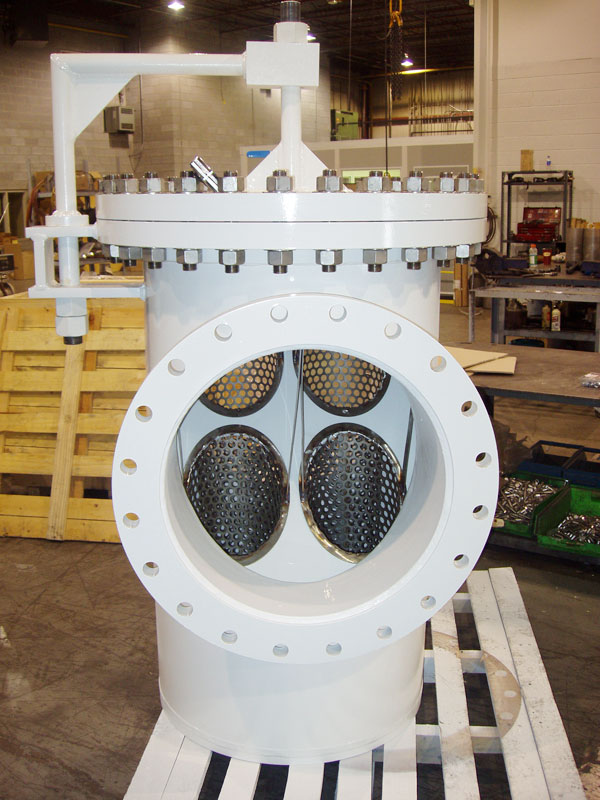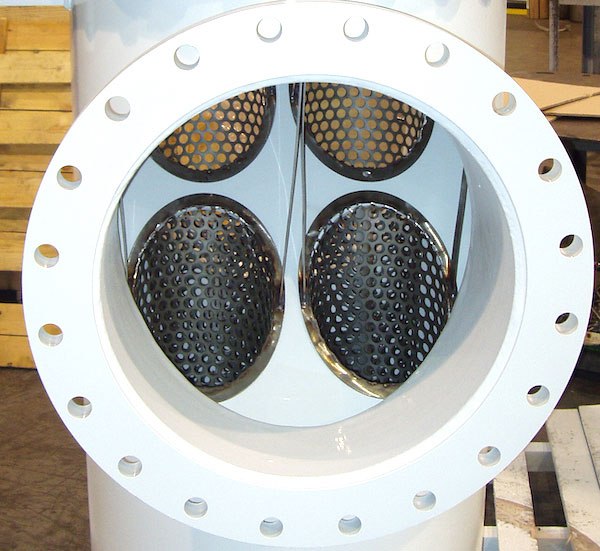So, are 4 strainer baskets better than one?
Like all things in life, and physics, there are always trade-offs.
We wanted to delve into a question that a recent product profile brought up.
The design of the large strainer below uses 4 smaller baskets inside rather than one large basket.

You can see that the unit includes a davit because the blind flange, which is the bolted cover on the top, would be extremely heavy to remove. Too heavy for an individual to do safely. So the davit allows the operator to lift and swing the blind flange out of the way to clean the baskets.
The majority of the units we ship would include one large strainer to be removed and cleaned. Depending on the application and material being strained, this could make removal somewhat of a challenge.
Having four smaller baskets as pictured above obviously makes this much easier, spreading out the weight that needs to be lifted to be removed.
From a strictly scientific basis you may be saying that having 4 smaller baskets will also increase the overall surface area. That is correct, and this should allow longer operation time of the process before the baskets get filled with strained material and must be removed and cleaned.
So far, using the 4-basket design is a no-brainer. Why wouldn’t we use it?
First off is cost. The four-basket design requires more engineering, more material to create that higher surface area, and more time to weld and fabricate. So it costs more. In a perfect world money may be no object, but in a modern competitive business environment, cost does enter into decision making.
Second and equally important is higher pressure drop.
Four small baskets have a higher clean pressure drop than one big basket. Clean pressure drop is the drop in pressure that results when the fluid being strained enters that strainer when it is new or has just been cleaned. Obviously over time as the strainer does its job and starts accumulating strained materials, it will require additional pressure to force the liquid through and therefore the pressure drop will be higher.
Let’s revisit that photo and zoom in where the fluid to be strained enters the strainer and encounters the baskets.

In the middle of the photo above, where the 4 baskets meet, you’ll basically see solid metal. This is where the majority of the flow enters the strainer as it comes in the inlet nozzle. The fluid therefore has to divert side to side to go through the baskets. This leads to more resistance and therefore increased pressure drop.
If you’re the operator, creating the pressure which forces that fluid through the process requires energy such as electricity or some fossil fuel, and these are input costs. Like many items in our lives these days, these are subject to fluctuations and right now many energy costs are pretty high. So the 4 basket design costs more to both build and to operate.
It also requires higher pressure to push that fluid through the line and this may require some other component of the process to have to be larger, and more expensive, like the pump that creates the pressure.
Basically, you want to minimize pressure drop across the strainer and to minimize the overall pressure drop in your line.
Too high pressure can also cause the basket itself to deform or in a worst-case scenario destruct. It’s not likely this will happen in a ‘clean’ pressure drop, but more likely in a ‘dirty’ pressure drop situation. Pressure drop increases as the basket starts to become filled with strained material. While regularly scheduled maintenance to keep the baskets clean is what’s required to avoid this, the real world often gets in the way. Maintenance crews get distracted with a failure elsewhere, or one of the input components that arrives from a new supplier has a higher amount of debris or material that needs to be cleaned. Suddenly that strainer can be under increased pressure and the production line operating in less than optional conditions.
So what at first seemed like a simple no-brainer answer to the question ‘are 4 strainers better than one’ suddenly doesn’t seem to be so straight forward.
It becomes influenced by a whole series of factors.
We’re always happy to work with our customers to evaluate these factors and help make the optimal choice for each application of our strainers. If you’ve got questions, our engineering department is here with solutions.

